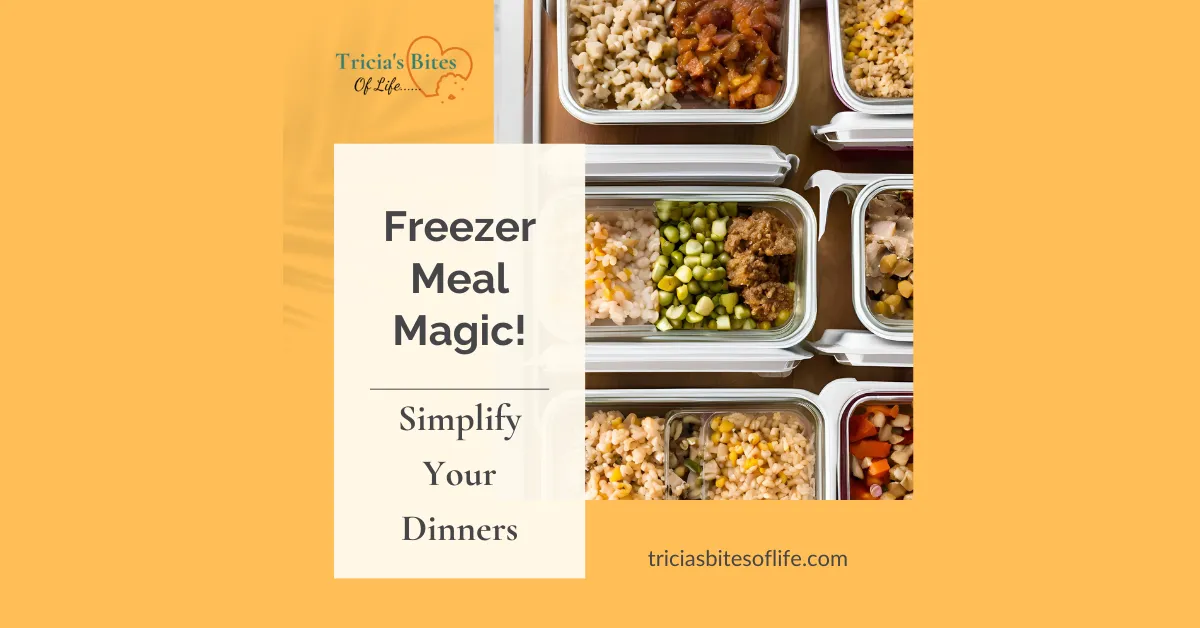
Freezer Meal Guide: Simplify Cooking with Easy Tips and Recipes
Freezer Meal Resource Guide: Simplify Your Cooking Routine!

I’m excited to share some of my favorite tips, tricks, and resources that will help you make the most of your meal prepping and freezer cooking. Whether you're looking to streamline your weeknight dinners, save money, or just reduce the dinnertime chaos, these websites have everything you need:
Thriving Home: This blog is full of meal plans, freezer meal recipes, and kitchen hacks that will make meal prepping a breeze. Don’t miss their freezer-friendly recipes that work great for the Instant Pot and slow cooker!
The Family Freezer: They specialize in dump-and-go freezer meals that don’t require any pre-cooking. Simply mix the ingredients, freeze, and cook when ready. Perfect for those who want quick and easy meals with minimal prep!
Happy Money Saver: A fantastic site for budget-friendly freezer meals that the whole family will love. They offer shopping lists, step-by-step guides, and creative recipes to keep your meal plan exciting and affordable.
These resources are perfect for anyone who wants to take control of their kitchen and simplify meal times. Be sure to check them out, and don’t hesitate to share your favorite recipes or ask questions here in the group.
Foods That Freeze Well in Freezer Meals

These ingredients hold up beautifully in the freezer, maintaining their flavor, texture, and quality when reheated:
Proteins:
Meat (Beef, Chicken, Pork, Turkey): Most cuts of meat freeze well, whether raw or cooked. Marinated meats, meatballs, and shredded meats are perfect for dump-and-go meals.
Fish and Seafood: Salmon, cod, shrimp, and other shellfish freeze well, especially when frozen raw.
Ground Meat: Cooks quickly and freezes well in sauces, casseroles, and chilis.
Vegetables:
Hard Vegetables (Carrots, Broccoli, Cauliflower): Best when blanched before freezing to preserve texture and nutrients.
Onions and Peppers: Great for adding flavor to dishes. Chop them raw and freeze directly or after sautéing.
Spinach and Kale: Works well in soups, casseroles, and smoothies, especially when blanched first.
Fruits:
Berries (Strawberries, Blueberries, Raspberries): Perfect for smoothies, baking, and breakfast dishes.
Bananas: Peel, chop, and freeze for smoothies or baking.
Mango and Pineapple: Great for salsas, smoothies, and stir-fries.
Grains and Pasta:
Cooked Rice and Quinoa: Freeze well for quick meal add-ins, just reheat gently.
Pasta: Best if slightly undercooked before freezing to avoid becoming mushy upon reheating.
Soups, Stews, and Sauces:
Tomato-Based Sauces: Marinara, Bolognese, and other tomato sauces freeze well without separating.
Broth-Based Soups: Chicken noodle, minestrone, and chili all freeze wonderfully.
Casseroles and Lasagnas: Assemble, freeze, and bake from frozen for easy dinners.
Dairy:
Cheeses (Shredded and Hard Cheeses): Freeze well, especially when pre-shredded for toppings or sauces.
Butter and Cream Cheese: Hold up well in cooked dishes, though texture may change slightly when thawed.
Foods That Do NOT Freeze Well (And Why)

These ingredients tend to lose their texture, flavor, or integrity after freezing. Here’s what to avoid:
High-Water Vegetables:
Cucumbers, Lettuce, and Celery: Become mushy and lose their crispness due to high water content.
Zucchini and Summer Squash: Better when blanched first, but raw slices often turn mushy.
Creamy Sauces:
Mayonnaise-Based Dressings: Mayonnaise and aioli will separate and curdle when thawed.
Cream Sauces: Alfredo and other heavy cream sauces can split when frozen, resulting in a grainy texture.
Fresh Herbs:
Basil, Cilantro, and Parsley: Lose their vibrant color and flavor, turning brown and mushy. Instead, chop and freeze in olive oil or broth in ice cube trays.
Dairy Products:
Soft Cheeses (Brie, Ricotta, Cottage Cheese): Tend to become grainy and separate when frozen.
Milk and Cream: Can separate and develop a curdled texture, especially when used in raw form.
Fried Foods:
Fried Chicken, French Fries: Lose their crispy texture and become soggy when reheated from frozen.
Cooked Eggs:
Scrambled Eggs and Hard-Boiled Eggs: Develop a rubbery texture and watery consistency after freezing.
Potatoes:
Raw or Boiled Potatoes: Become grainy and watery when thawed. Instead, use potatoes in soups or mashed form where texture changes are less noticeable.
Why Some Foods Don’t Freeze Well:
Water Content: High-water foods tend to become mushy or lose texture when frozen due to ice crystal formation.
Fat Separation: Creamy and fatty foods can separate, leading to a grainy or curdled texture.
Crispness Loss: Foods like lettuce lose their crisp texture, turning limp and unappetizing.

Tips to Maximize Freezing Success:
Blanch Before Freezing: Briefly cooking certain veggies before freezing can preserve their texture and color.
Avoid Air Exposure: Use airtight containers or bags to prevent freezer burn.
Label Everything: Include the date and any reheating instructions to keep things organized.
With this guide, you'll have a better idea of which ingredients will turn your freezer meals into delicious, satisfying dinners and which to leave out to avoid mealtime disappointments! 🥶🍲 Let me know if you’d like more tips or specific recipe ideas!
We’re all in this together! 💪🍽️
Let’s keep those freezers stocked and those dinner tables happy!
